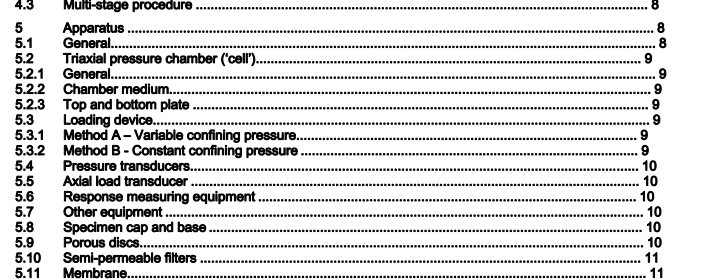BS EN 13286-7:2004 – Unbound and hydraulically bound mixtures — Part 7: Cyclic load triaxial test for unbound mixtures

1 Scope
This European Standard specifies test procedures for determining the resilient and permanent behaviour of unbound mixtures under conditions that simulate the physical conditions and stress states of these materials in pavement layers subjected to moving loads. These procedures allow to determine mechanical properties that can be used for performance ranking of materials and for calculating the structural responses of pavement structures.
The test is applicable to cylindrical specimens of unbound mixtures prepared by laboratory compaction, with an absolute maximum particle size smaller than one fifth of the specimen diameter.
For the loading of the specimen, two methods are provided :
Method A: The Variable Confining Pressure method in which the cell pressure is cycled in phase with the axial load.
Method B: The Constant Confining Pressure method in which only cyclic axial loading and constant confining pressure are performed.
2 Normative references
This European Standard incorporates by dated or undated reference, provisions from other publications.
These normative references are cited at the appropriate places in the text and the publications are listed hereafter. For dated references, subsequent amendments to or revisions of any of these publications apply to this European Standard only when incorporated in it by amendment or revision. For undated references the latest edition of the publication referred to applies (including amendments).
EN 13285, Unbound mixtures – Specification.
3 Symbols and abbreviations
For the purposes of this European Standard, the symbols and definitions in Table 1 apply.
4 Principle The cyclic triaxial test consists of imposing, on a cylindrical specimen of unbound granular material, cyclic stresses that reproduce the stress range in an unbound pavement layer, and in measuring the axial and radial strains of the specimen induced by this loading. In method A (Variable Confining Pressure), a cyclic axial deviator stress and a variable (cyclic) confining cell pressure, varying in phase, are applied. A simplified stress regime with a cyclic axial deviator stress and a constant confining pressure may also be adopted, method B. The standard proposes three different test procedures, described below.
4.1 Procedure for the study of the resilient behaviour The resilient behaviour of the material represents the behaviour during one load application. The results of the test can be used to determine values of the elastic modulus of the material for different stress levels, or parameters of non linear elastic models which can be used in analytical and numerical pavement design procedures. In this procedure, a cyclic conditioning is first applied to stabilise the permanent strains of the material and attain a resilient behaviour. This conditioning is performed by applying a large number of cycles of a stress path that corresponds to the maximum stress level applied during the test. The resilient behaviour is then observed for several stress paths applied each one with a small number of cycles on the same specimen.
4.2 Procedure for the study of permanent deformations Each permanent deformation test consists in applying a large number of load cycles of a single stress combination, without prior conditioning. This procedure can be used to determine permanent deformations of the material for a particular stress level, or parameters of models of prediction of permanent deformations, which can be used for pavement analysis and design.
BS EN 13286-7:2004 – Unbound and hydraulically bound mixtures — Part 7: Cyclic load triaxial test for unbound mixtures